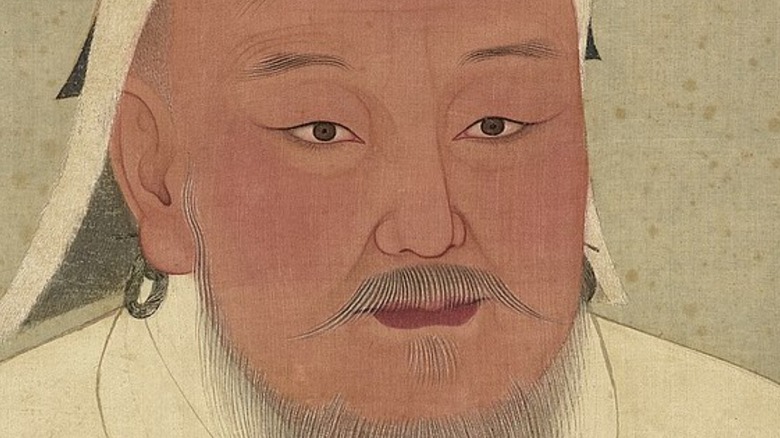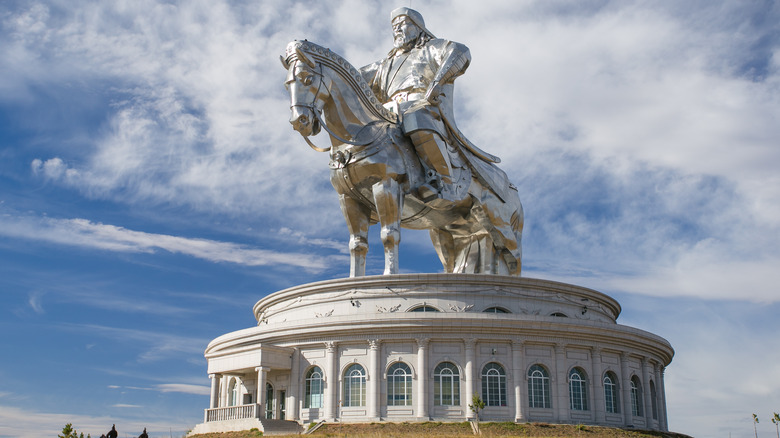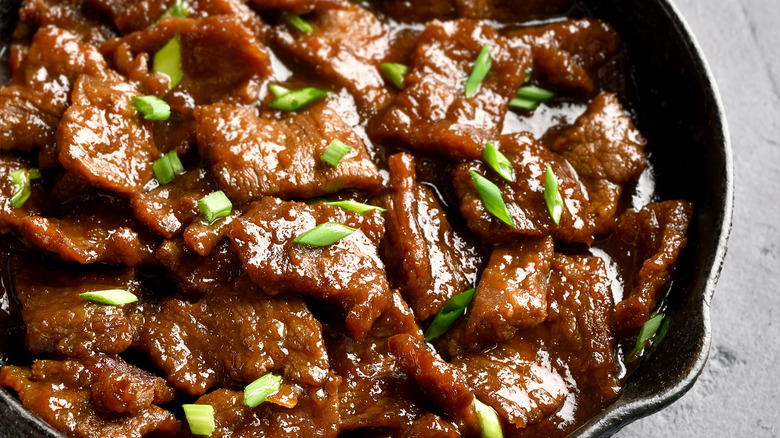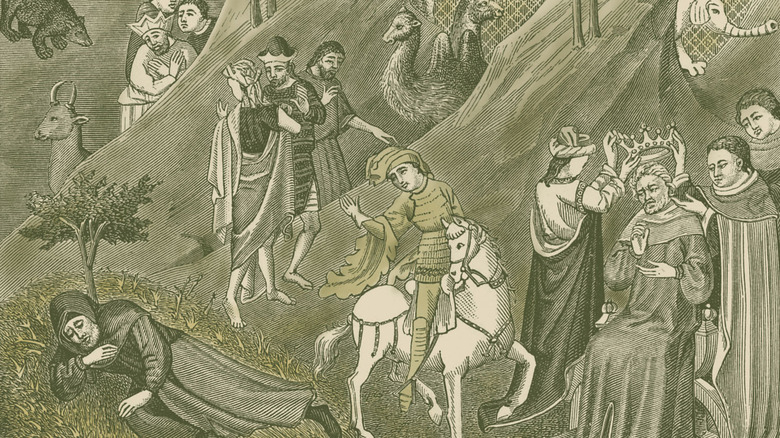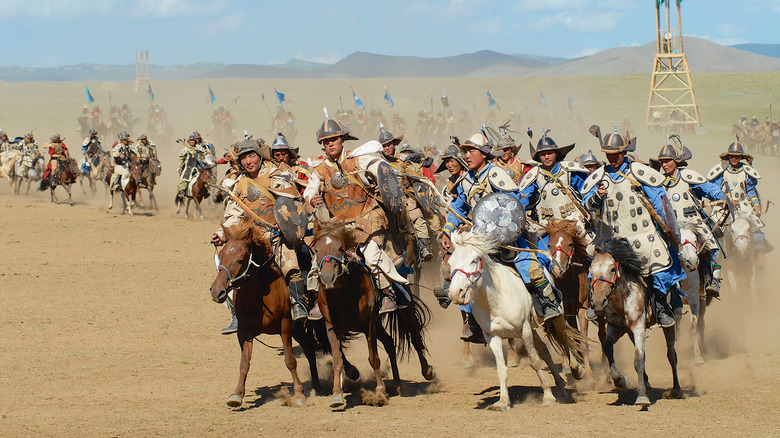The Extreme Measures The Mongol Army Had To Take To Stay Alive
The Mongol empire headed by Genghis Khan was one of the most successful — and the largest — empires the world has ever seen, according to LiveScience. The lengths and measures the Mongols had to overcome to gain this title was no easy feat, however, as Mongolia is not known to be a very hospitable land to any people.
Marked by droughts, grueling winters, and short but extremely hot summers, the Mongol homeland was a challenging place, as History on the Net points out. In the end, this harsh environment might've been their greatest gift. Forced to resort to a nomadic lifestyle, the Mongols were no strangers to having to travel long distances, which helped significantly in their conquest of the Asian and European continents. Coupled with great battle tactics, technology, and their mobile but frugal lifestyle, Genghis Khan led his army to victory after victory, and in time, conquered much of the world.
Forging an empire
To understand how the Mongols survived, first recognize Genghis Khan and his expertise in military tactics. Genghis Khan did not have an easy upbringing, as his mother had been forced into marriage with his father, and when his father was killed when Genghis Khan was 10, he, his mother, and his siblings were exiled from the tribe (via History).
Over time, Genghis Khan eventually made it back into the upper ranks of Mongol tribal society, and through tactics like rewarding competency over heredity (via History), he eventually united the warring tribes, but he would have his eyes on even greater ambitions. This was only the start of Genghis Khan's future invasion of much of China, modern-day Russia, and Eastern European countries. But reasonable leadership skills weren't the only thing Genghis Khan knew how to implement. In order to spread his forces beyond the steppes from where they originated, he needed to feed his army, and that proved to be an exceptional challenge.
Lactose Intolerance Farewell
Due to Mongolia's inhospitable environment and land that was very difficult to farm, the Mongol army faced exceptional hardships when it came to feeding their soldiers. As a result, much of their diet was based on dairy products, according to Harvard Magazine. There have been many questions on how the Mongols utilized such a diet, as 95% of members from the Eastern steppe population today are lactose intolerant.
Some researchers suspect that the Mongol warriors might've had an altered microbiome in their gut that allowed them to digest lactose at the rates that the soldiers consumed it, according to Harvard Magazine. The Mongols for the most part ate yogurt, cheese, milk curds, and an alcoholic drink called kumiss, or airag, that was made by fermenting milk from a mare, according to History on the Net. When the Mongols would take stops, sometimes they would drink straight from their mare.
Meat and Cheese
Since vegetation was sparse, the Mongols relied on the meat from killing the cattle that journeyed along with them. However, any animal would really suffice, according to History on the Net. They would sometimes make stews if they could find wild-growing plants such as onions or berries. One of the most innovative food items the Mongols consumed, however, was a quick meal made for travelling purposes. They would put some meat and vegetables in a bag, which a Mongol soldier would place underneath their saddle, and use the body heat from the rider and the horse to cook the food (via History on the Net).
Some researchers today think that Genghis Khan's army might've had one stroke of luck, and that was a period of fairer climate in Mongolia at the start of Khan's conquest, according to National Geographic. Some people suspect that the climate at the time might've allowed grass and other plants to grow more fruitfully, which would've provided a more diverse diet for the horses and other livestock of the Mongols. This, in turn, would give the Mongols the ability to harvest more dairy products, along with providing them with healthier, and more plentiful, meat.
Creating an empire
As Genghis Khan and his Mongol army expanded into Eurasia, they would alter the way they harvested food. For example, once in China, the Mongols were able to produce goods like rice and flour, according to History on the Net. However, it was also Genghis Khan's institutions that helped produce more goods. Genghis Khan implemented rural cooperatives in China as he began to conquer the nation, as National Geographic points out. By doing this, he not only yielded more crop growth for his soldiers to use as food, but he also helped increase tax revenue, which continued to support his vast and growing empire (per National Geographic).
The Mongol horse was also a huge benefit to Genghis Khan's military. It's estimated that the Mongol armies were able to travel anywhere from 60 miles to 100 miles a day, which had been the fastest rate any military group had been able to move in all of history, until mechanized warfare in the 20th century (via History on the Net). The Mongols' nomadic style wasn't the only tool in the box that helped foster an expansive empire; Genghis Khan's utilization of then-modern technology, coupled with his aggressive military tactics, would prove to be very successful, according to History on the Net.
Technology and military tactics
The Mongol warriors had to have exceptional endurance for their fast-paced nomadic lifestyle, and were trained for just that, according to History on the Net. They also utilized new technologies of the time, such as a special bow which was composed of wood, horn, and sinew that had incredible range (via History on the Net). This helped the Mongols tremendously since they often fought on horseback, and could begin firing on the enemy from farther distances.
If there's anything the Mongols are known for, it's their ruthless and often barbaric acts of warfare, according to Discover Magazine. As the Mongols continued expanding across Asia, their reputation inspired more and more fear. When the Mongol army invaded China, for example, they lay siege to many cities, while setting the countryside ablaze (per the History Channel). Genghis Khan also had a surrender-or-die policy, according to History Extra, which resulted in even more bloodshed. They were able to move from battle to battle not only because of their incredible endurance, but with the use of lighter horses that could travel farther, according to History on the Net. The nomadic life may have been grueling, but used in combination with Genghis Khan's tactical skills, along with new weapons technology, the Mongols proved themselves to be one of the most successful armies the world has ever seen.
